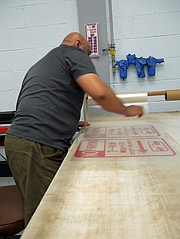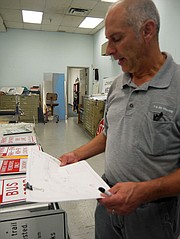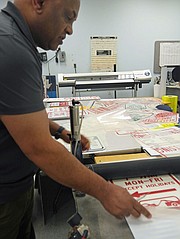Alexandria — The black wedge jerks back and forth, making small cuts in the shiny red vinyl. Two or three minutes later Abraham (“they call me Abe here”) Kifle, sign fabricator for the City of Alexandria, cuts off the 24-inch rectangle from the large roll with his sharp blade. He peels back the strips of sticky red vinyl, revealing two printed 18x24 inch "NO Parking 7-9 am" signs. Kilfe says that signs printed on this material last about 10 years. He has another printer using different software that is used for things like posters and advertisements that last about half as long.
Kilfe says making signs years ago was more like crafting but now technology has changed with all of the software. “We have a new different printer to keep up with technology and save the city money instead of outsourcing.”
Rick Aslanian who used to be the sign fabricator and has now moved up the line, says they usually have a project. He pulls a plan for a stretch of about an eighth of a mile on Stevenson Avenue between S. Whiting and Stulz that Kifle will begin next Monday. This is part of Alexandria's Complete Street initiative and will involve making about 18 new signs for moving bus stops, making it more bike friendly and safer for pedestrians and putting in a median strip. The project will take about a week to complete.
Kilfe had started the process by creating a layout on his computer of the signs he would need for the current Washington Street project. When he had completed the design for all of the signs, he sent off a proof. Now that he had the OK, he was in the middle of the several step process for every sign to become a finished product, ready to install at the site. Kilfe transfers the file to the machine behind him that prints off his signs in red, green or blue vinyl.
The door opens. Three city public works employees have come to pick up some signs they had requested in an urgent call earlier in the morning. "Please excuse the mess. We will be resurfacing this part of the trail from _to __". The hours had been left blank. Kifle explains that he is given his work orders and priorities for projects. However, if a critical sign is needed due to something unexpected, like an accident with a STOP sign knocked down, and it has to be replaced as soon as possible, that will take priority. He said people also call in or put it in the network if they see a sign that needs to be replaced.
Kilfe lines up his newly created No Parking sign in front of a machine with transfer tape. He pulls off a strip and rolls it over the sign to provide a sticky surface for the next stage. The final step is inserting the sign under a pressure roller as the transfer tape attaches the sign to the unbendable alpolic aluminum. He makes one sign at a time all the way through the process. He said, “I will do about 10 signs today.”
"Now this is a little different." He pulls up a graphically designed apple with a slogan "Food: Too Good to Waste." He had produced this poster for the Alexandria Solid Waste Department. If I print this and it is a little blurry, the software helps me; it allows me to auto trace." Sometimes he doesn't have the exact color in the palette, "but I have a lot of tools to work with."
Kifle is Eritrean, having arrived in America from Ethiopia 20 years ago, bringing his relatives with him for a better life. For some years he was self-employed and says he has been working for the City of Alexandria for eight years and still maintains his business part time. Kilfe says he originally got interested because his friend was an architect, "seeing him do house plans." So after high school Kilfe took three years of training at Addis Tech in architectural drafting.
Kilfe says when he is driving around, he feels good. "I think we'll need a new sign there." Kilfe turns back to the computer. "We need so many signs, it's unbelievable."




